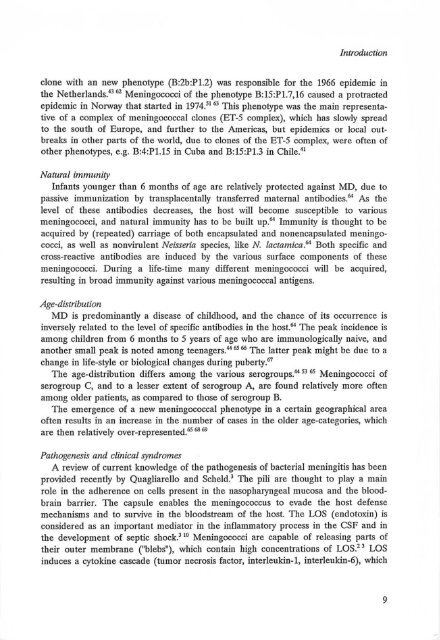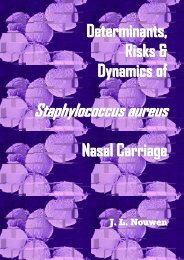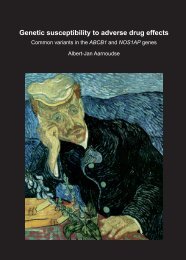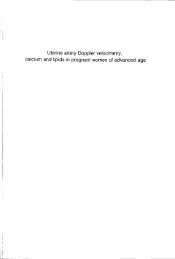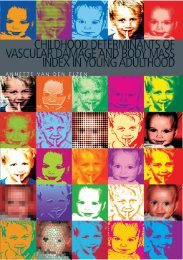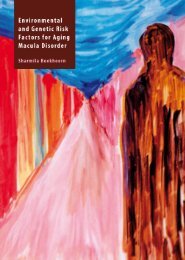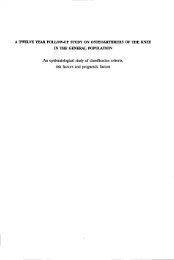An attempt at an epidemiological explanation - Epib.nl
An attempt at an epidemiological explanation - Epib.nl
An attempt at an epidemiological explanation - Epib.nl
- No tags were found...
Create successful ePaper yourself
Turn your PDF publications into a flip-book with our unique Google optimized e-Paper software.
Introductionclone with <strong>an</strong> new phenotype (B:2b:P1.2) was responsible for the 1966 epidemic inthe Netherl<strong>an</strong>ds." 62 Meningococci of the phenotype B:1S:P1.7,16 caused a protractedepidemic in Norway tb<strong>at</strong> started in 1974." 63 This pbenotype was the main represent<strong>at</strong>iveof a complex of meningococcal clones (ET-S complex), which has slowly spreadto the south of Europe, <strong>an</strong>d further to the Americas, but epidemics or local outbreaksin other parts of the world, due to clones of the ET-5 complex, were often ofother phenotypes, e.g. B:4:Pl.lS in Cuba <strong>an</strong>d B:1S:P1.3 in Chile."N<strong>at</strong>ural immunityInf<strong>an</strong>ts younger th<strong>an</strong> 6 months of age are rel<strong>at</strong>ively protected against MD, due topassive immuniz<strong>at</strong>ion by tr<strong>an</strong>splacentally tr<strong>an</strong>sferred m<strong>at</strong>ernal <strong>an</strong>tibodies" As thelevel of these <strong>an</strong>tibodies decreases, the host will become susceptible to variousmeningococci, <strong>an</strong>d n<strong>at</strong>ural immunity has to be built up." Immunity is thought to beacquired by (repe<strong>at</strong>ed) carriage of both encapsul<strong>at</strong>ed <strong>an</strong>d nonencapsul<strong>at</strong>ed meningococci,as well as nonvirulent Neisseria species, like N. lactarnica. M Both specific <strong>an</strong>dcross-reactive <strong>an</strong>tibodies are induced by the various surface components of thesemeningococci. During a life-time m<strong>an</strong>y different meningococci will be acquired,resulting in broad immunity against various meningococcal <strong>an</strong>tigens.Age-distributionMD is predomin<strong>an</strong>tly a disease of childhood, <strong>an</strong>d the ch<strong>an</strong>ce of its occurrence isinversely rel<strong>at</strong>ed to the level of specific <strong>an</strong>tibodies in the bost." The peak incidence isamong children from 6 months to 5 years of age who are immunoiogically naive, <strong>an</strong>d<strong>an</strong>other small peak is noted among teenagers." 0560 The l<strong>at</strong>ter peak might be due to acb<strong>an</strong>ge in life-style or biological ch<strong>an</strong>ges during puberty."The age-distribution differs among the various serogroups." S3 os Meningococci ofserogroup C, <strong>an</strong>d to a lesser extent of serogroup A, are found rel<strong>at</strong>ively more oftenamong older p<strong>at</strong>ients, as compared to those of serogroup B.The emergence of a new meningococcal phenotype in a certain geographical areaoften results in <strong>an</strong> increase in the number of c.:1Ses in the older age-c<strong>at</strong>egories, whichare then rel<strong>at</strong>ively over-represented. 656869P<strong>at</strong>hogenesis <strong>an</strong>d clinical syndromesA review of current knowledge of the p<strong>at</strong>hogenesis of bacterial meningitis has beenprovided recently by Quagliarello <strong>an</strong>d Scheld.' The pili are thought to play a mainrole in the adherence on cells present in the nasopharyngeal mucosa <strong>an</strong>d the bloodbrainbarrier. The capsule enables the meningococcus to evade the host defensemech<strong>an</strong>isms <strong>an</strong>d to survive in the bloodstream of the host. The LOS (endotoxin) isconsidered as <strong>an</strong> import<strong>an</strong>t medi<strong>at</strong>or in the inflamm<strong>at</strong>ory process in the CSF <strong>an</strong>d inthe development of septic shock.' \0 Meningococci are capable of releasing parts oftheir outer membr<strong>an</strong>e ("blebs"), which contain high concentr<strong>at</strong>ions of LOS." LOSinduces a cytokine cascade (turnor necrosis factor, interleukin-l, interleukin-6), which9


